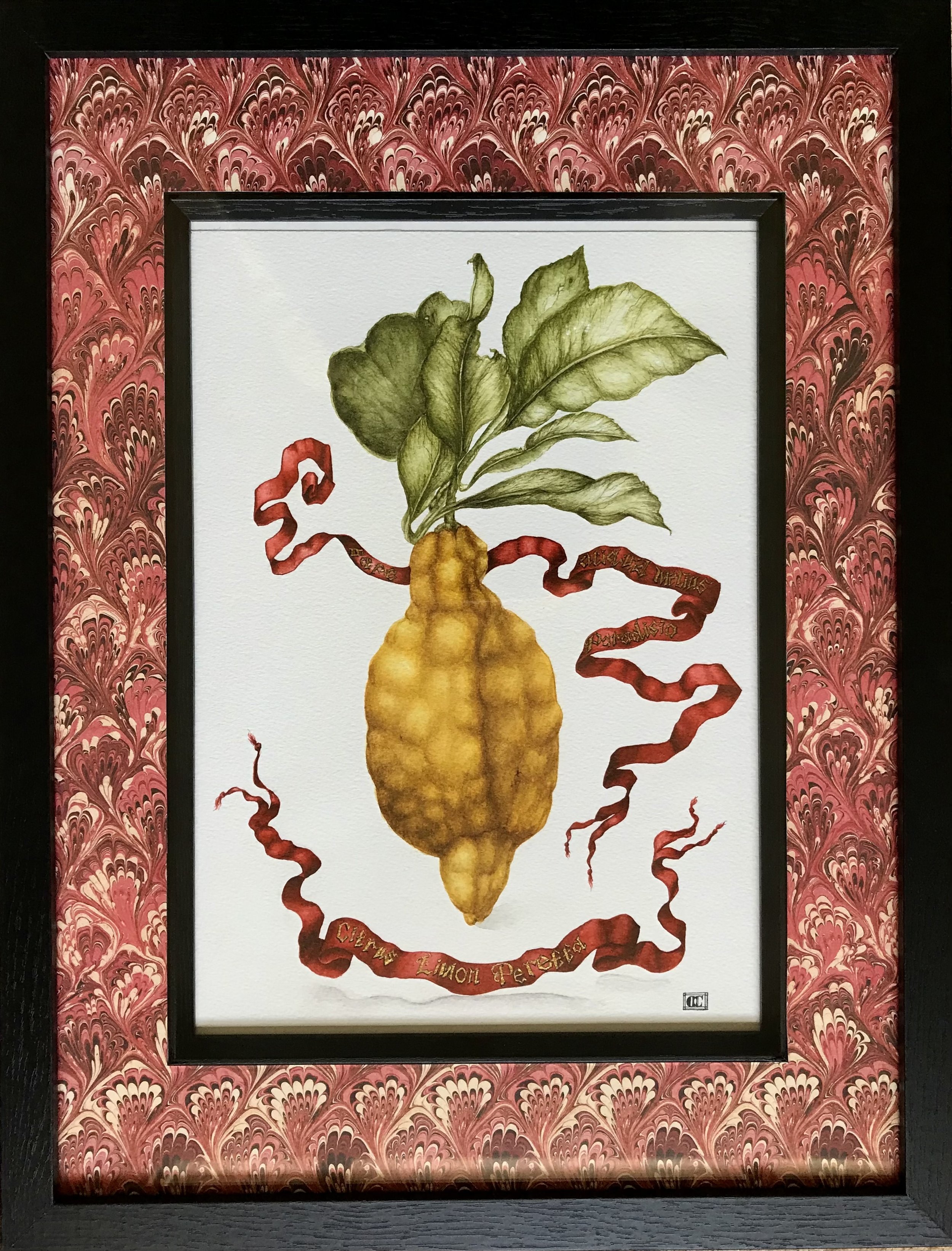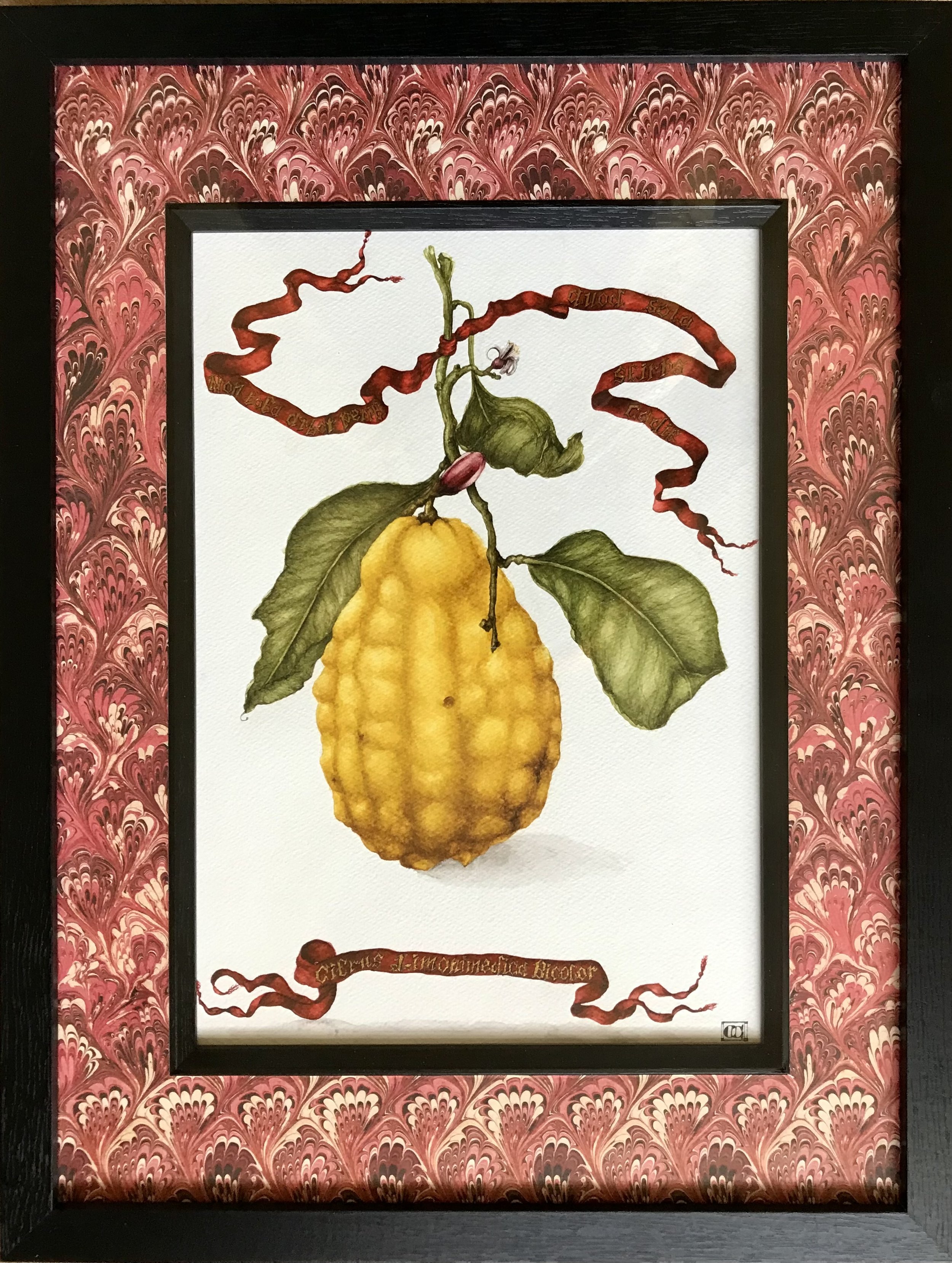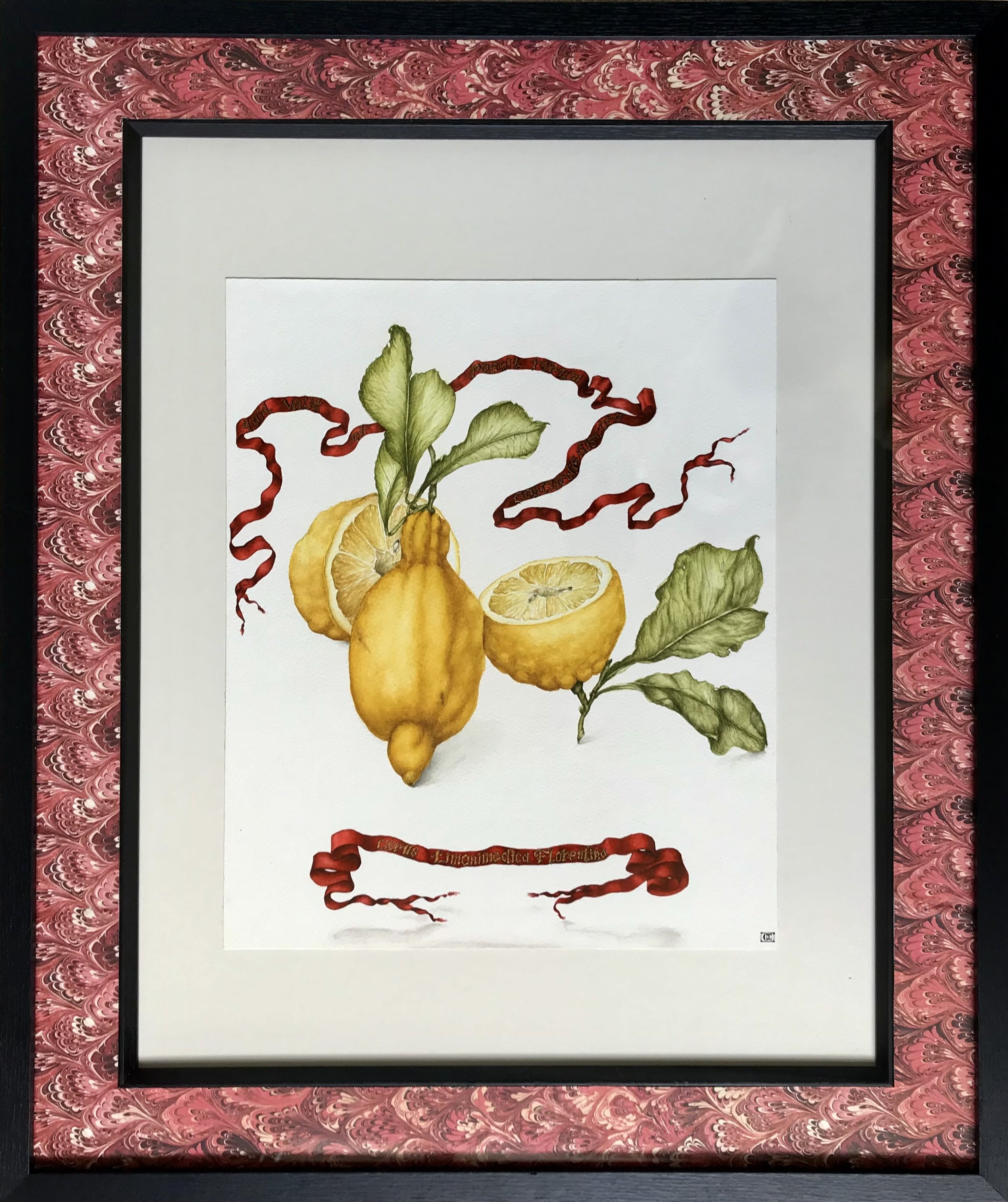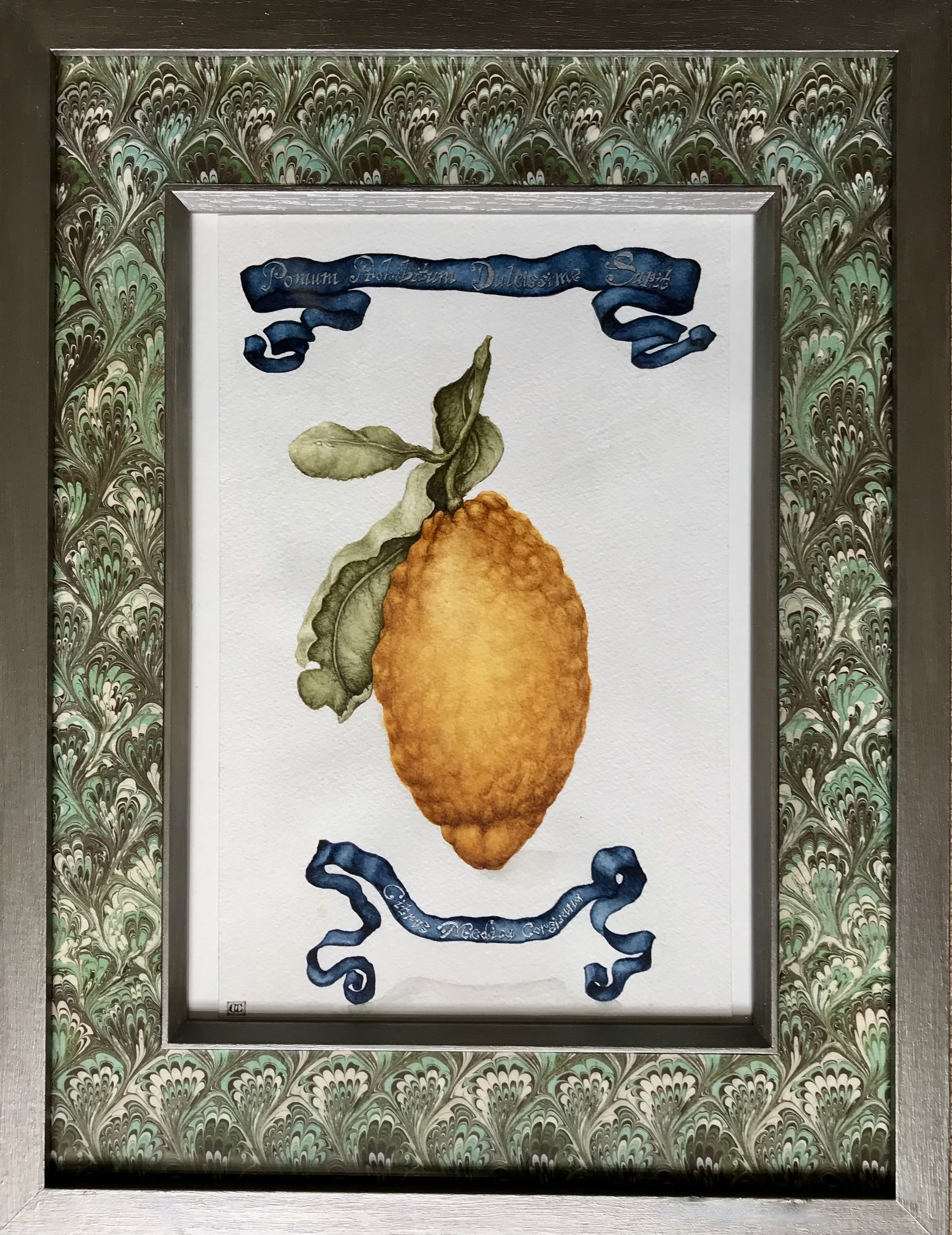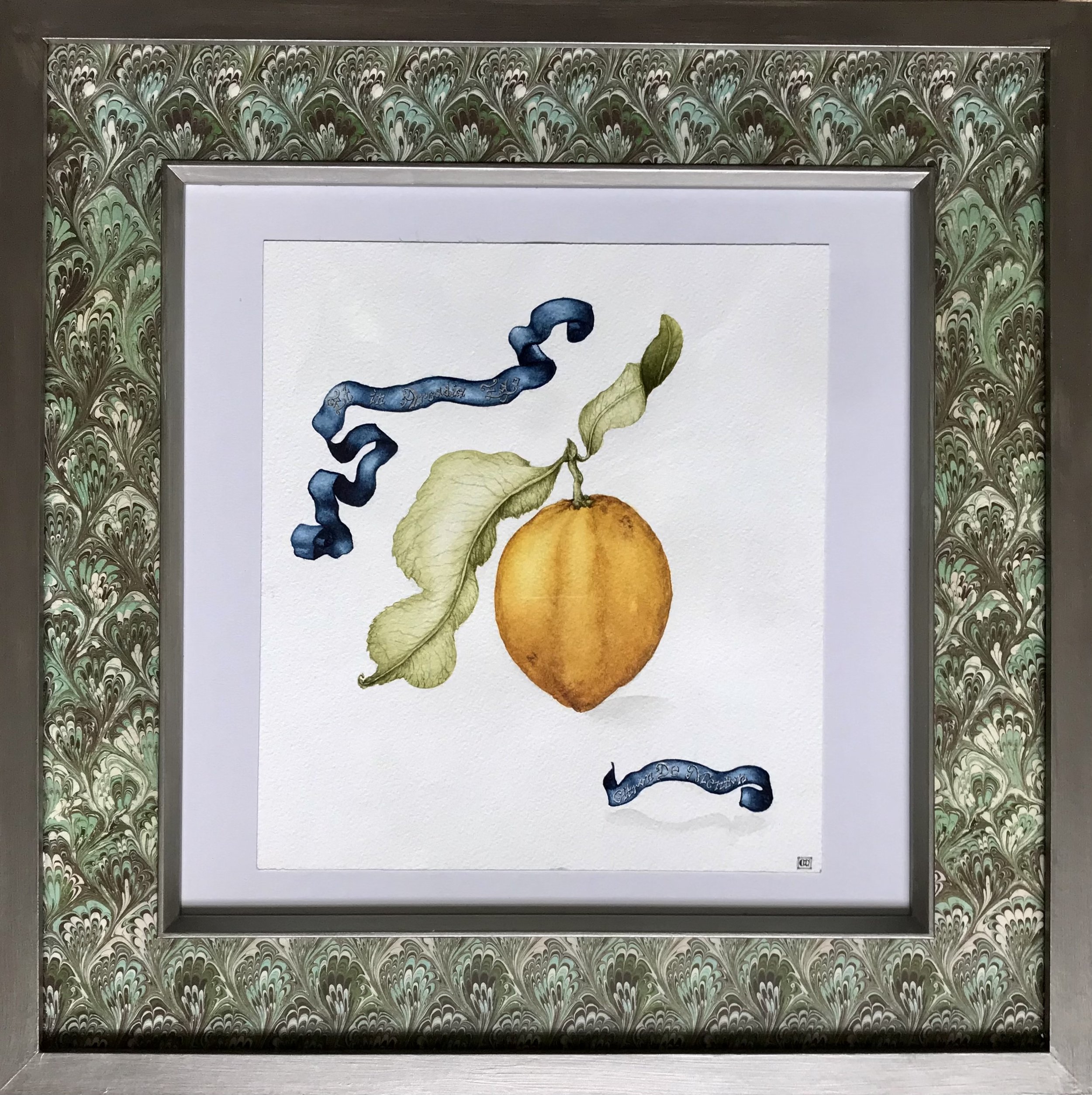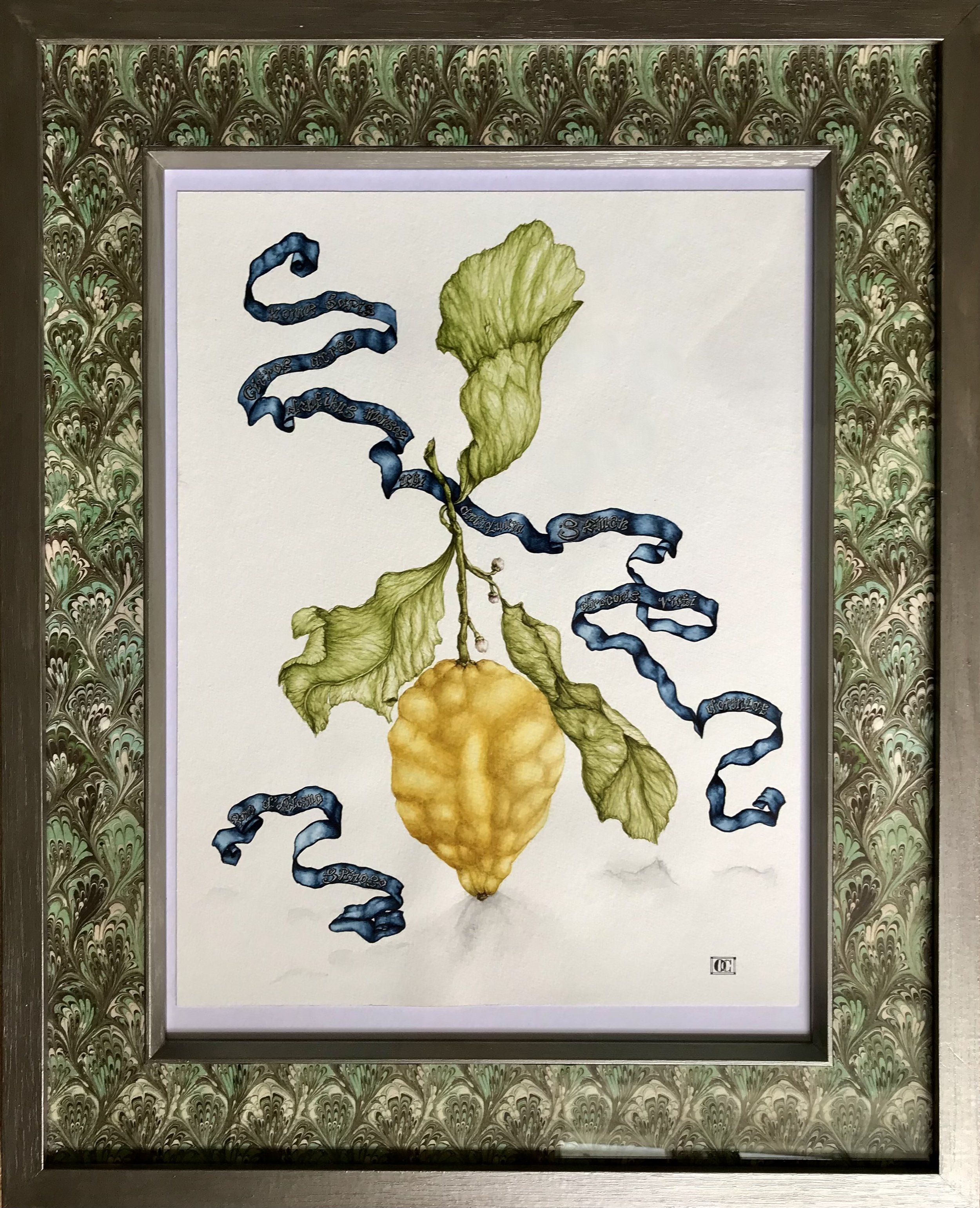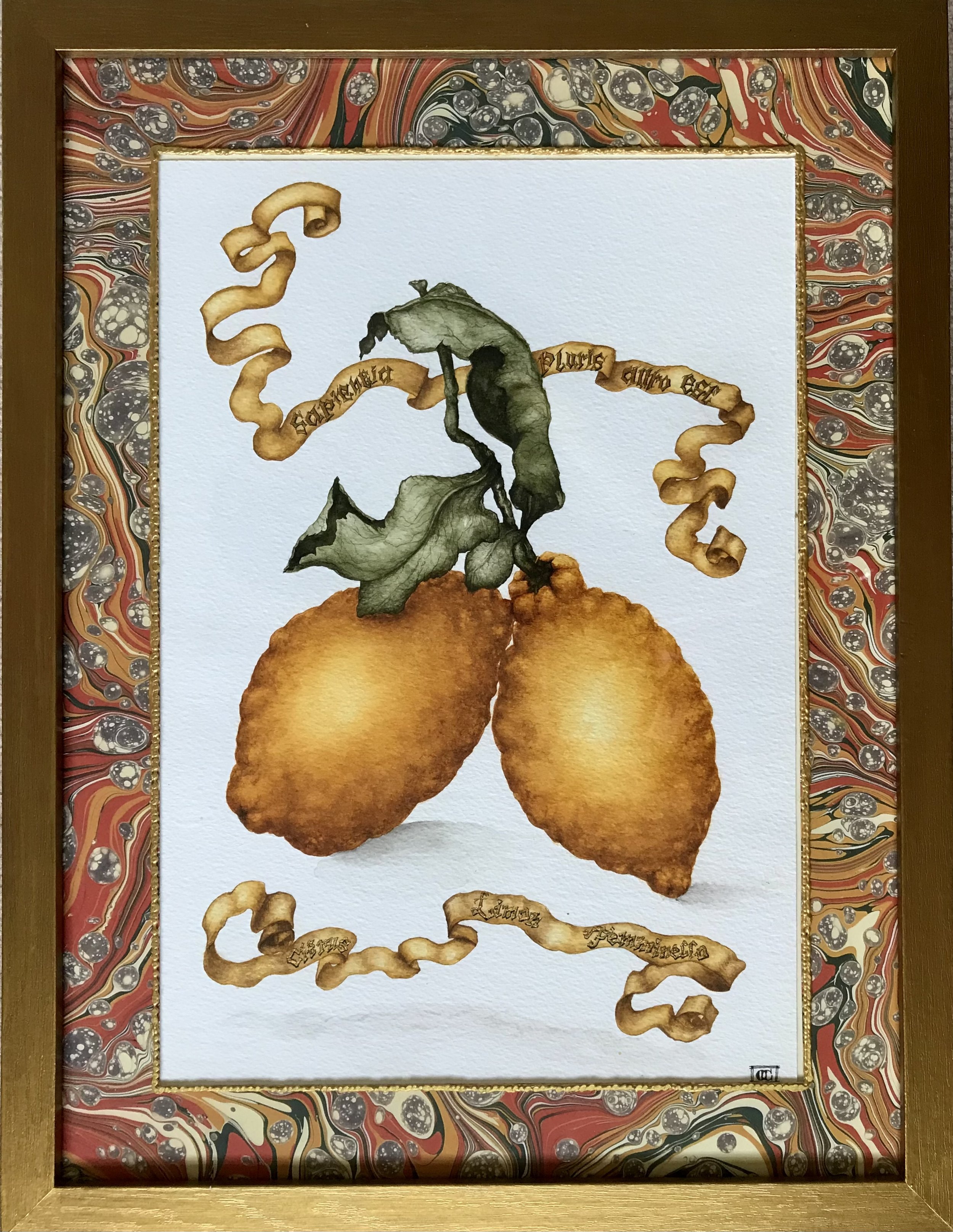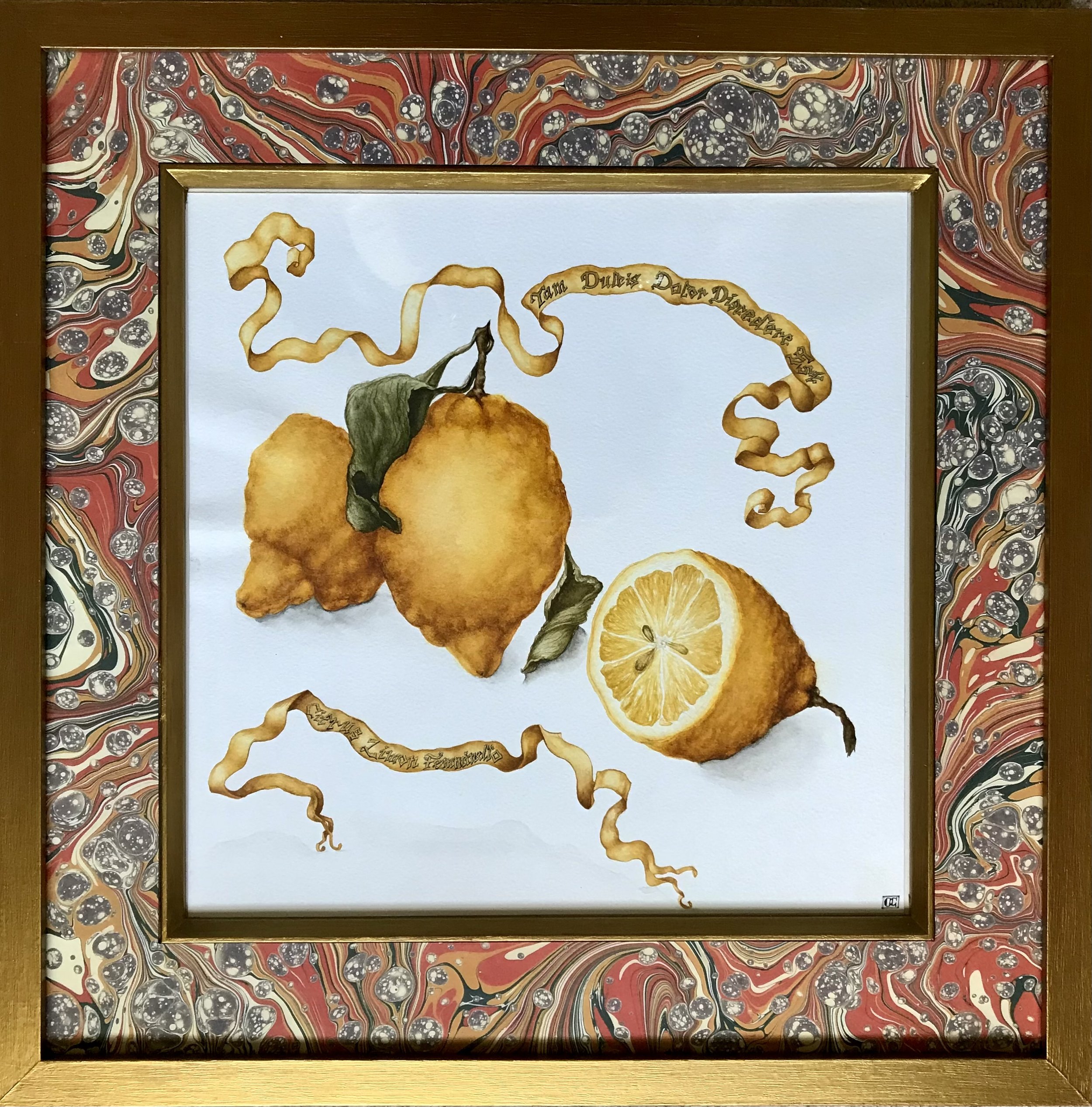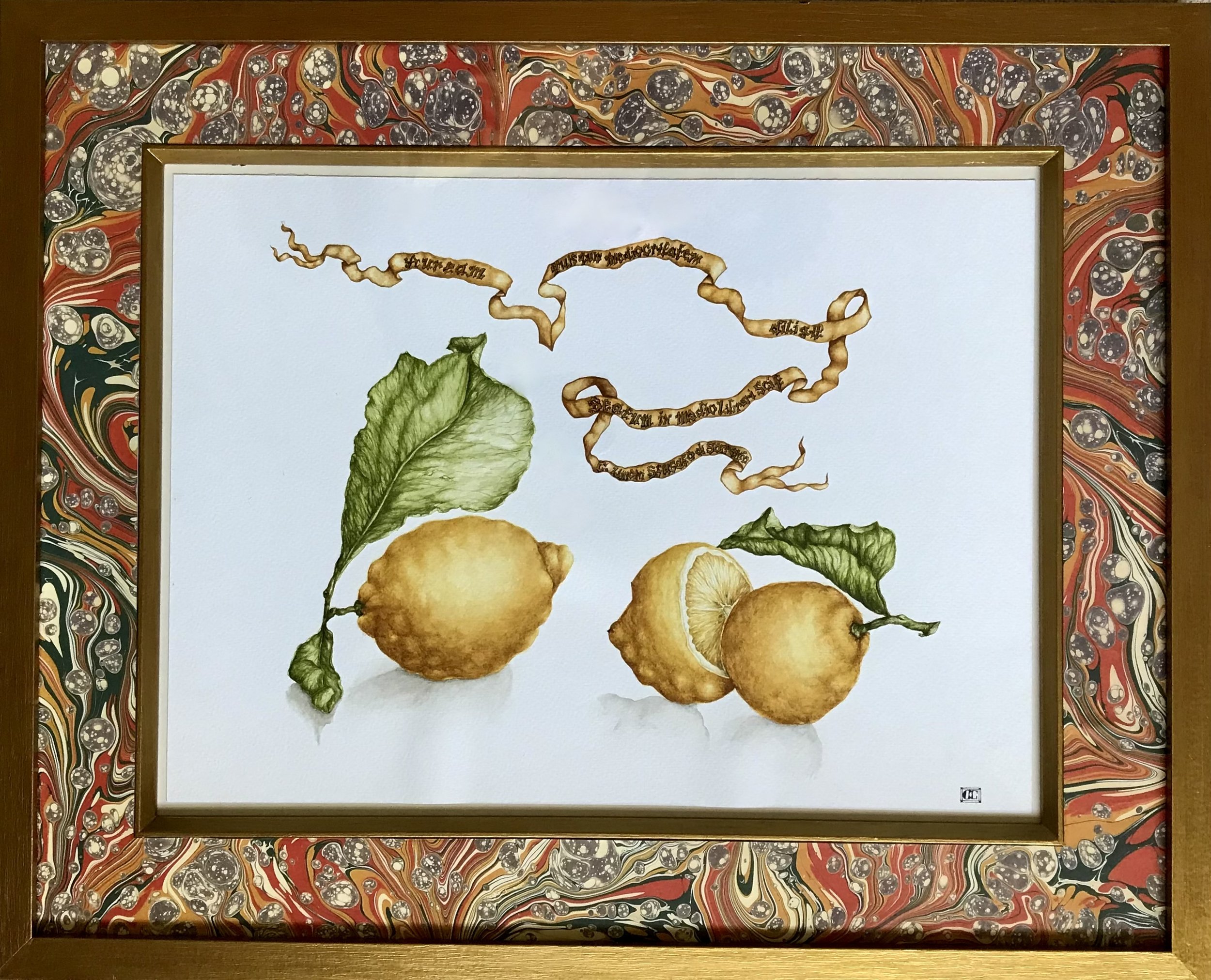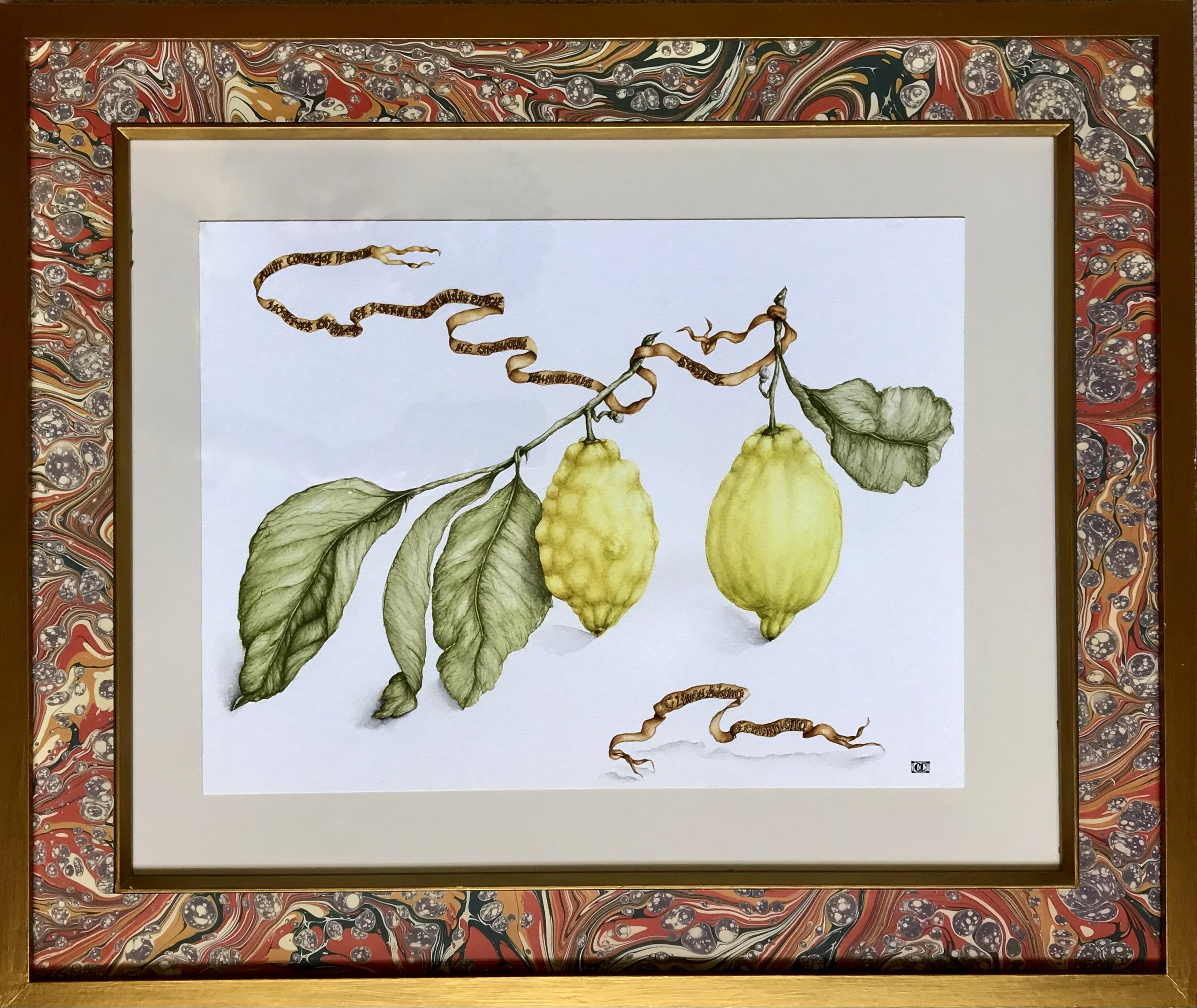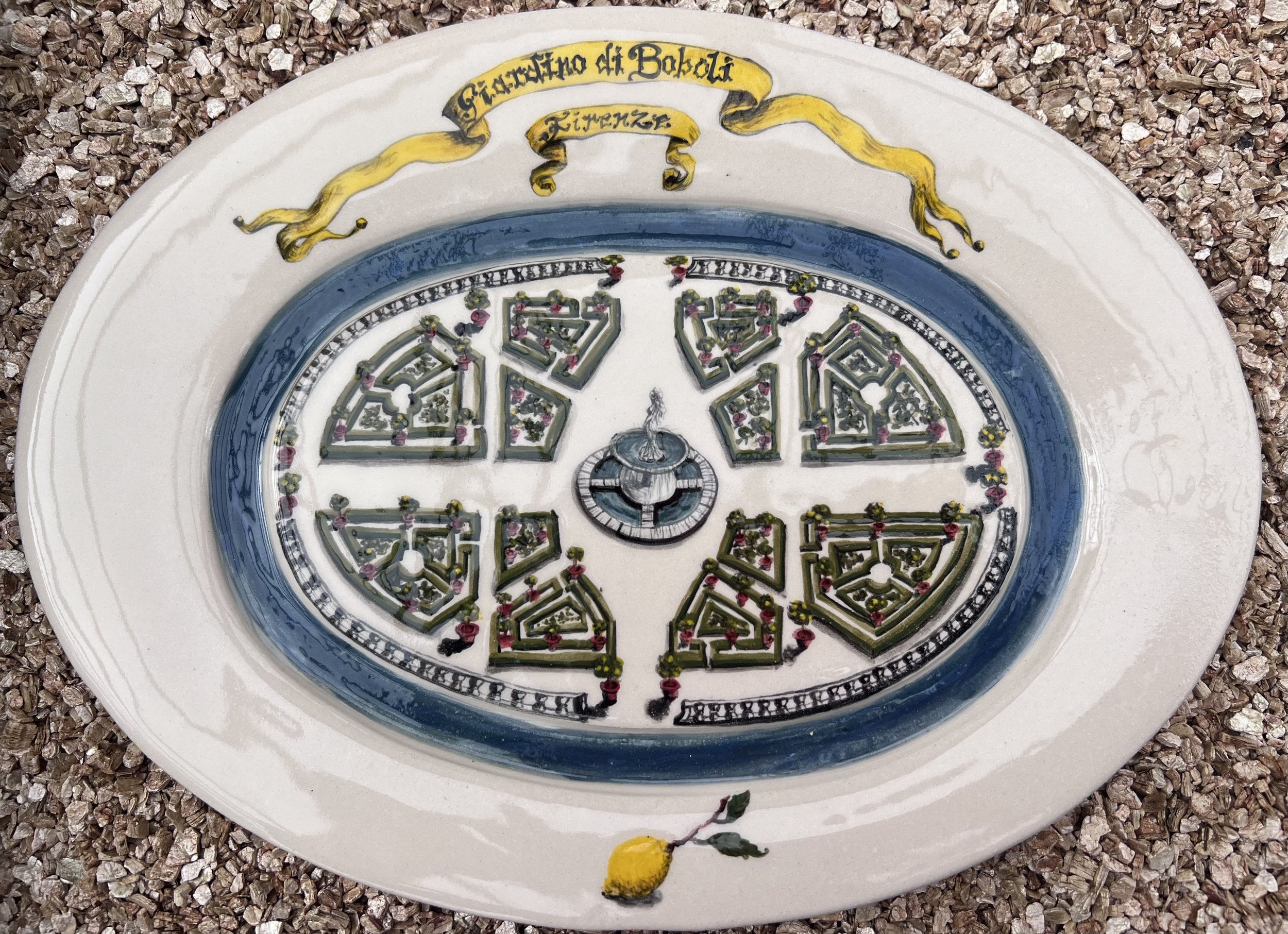'Plucked from Paradise'
The focus of this exhibition of artwork, staged in the Limonaia (a term for a greenhouse developed in the Italian Renaissance specifically for lemons), was to showcase a handful of the most precious and unusual citrus varieties as seen on the artist's quest to find the fruit of paradise, this being, in fact, a citrus fruit.
The Legendary Lemon
According to the ancient Greek legend, in the paradise garden of the Hesperides (the three goddess-nymphs who tended to the divine fruits: Aegle the citron, Arethusa the lemon and Hesperia the orange) stood a marvellous tree laden with golden fruit and guarded by a ferocious dragon. These fruits were regarded as the source of the gleaming light at sunset and indeed, the glow of a lemon still holds the power to dispel the gloom on even the darkest day and transport one away to a paradise place bathed in sunlight.
One of these golden fruits was also the seed of strife that consequently lead the Trojan War. For Eris, the goddess of strife, inscribed onto the fruit the words τῇ καλλίστῃ ('For the Fairest’ ) and cast it amongst the goddesses at the wedding feast of Peleus and Theits (from which she had not been invited). The fruit sparked a contest between Hera, Athena and Aphrodite to claim it and the title of the fairest of the goddesses.
In Menton on the French Riviera, it is believed that the lemon was the original forbidden fruit in the Garden of Paradise and every year a spectacular festival (the Fête du Citron) is held in honour of the lemon. For legend has it that when Adam and Eve were expelled from Eden, Eve plucked a lemon from the paradise garden to take with her in their exile. Adam, fearing eternal condemnation, begged her to cast it away. Eve agreed, on the condition that she choose the spot and thus she founded Menton, seeding a new paradise where the conditions were perfect for cultivating the lemon that far north.
Citrus Studies
This series of watercolour paintings are more like portraiture than classic still lifes: each lemon is a character, full of attitude and individuality. The style of composition was influenced by the botanical illustrations from the Italian Renaissance gathered in the volumes of J. C. Volkamer's Nürnbergische Hesperides and Giovanni Battista Ferrari's Hesperides sive de Malorum Aureorum Cultura et Usu. Their books contained wonderfully whimsical images of the rarest and most bizarre citrus fruits, suspended above grand garden vistas and adorned with ribbons declaring their species. The artist has expanded upon their use of ribbons to incorporate poignant excerpts of poetry and words of wisdom from the past.
All are painted in watercolour on paper and framed by the artist using Italian marble paper. The citrus fruits are all depicted true to scale and form.
pomaque ab insomni concustodita dracone.
‘and the fruit guarded by the sleepless dragon.'
CITRUS LIMONIMEDICA
Watercolour on paper, framed with red Italian marble paper. (9"x 11")
A verse from the Roman poet Ovid's Metamorphoses Book 9, which speaks of the dragon that guards the divine fruit in the garden of the Hesperides. In the spirit of Hercules, who once stole the golden fruit that grew in the goddesses' garden, this golden lemon was plucked from the gardens of the D’Este Villa in Tivoli. Cardinal Ippolito II D’Este had envisioned the villa's garden as his very own paradise garden of the Hesperides and there are various references to Hercules entwined in it, as the hero was reputed to be a protector of the Tiburtine region, where the villa is located and an ancestor of the D’Este family, whose motto is a variation on Ovid's line: ab insomni non custodita dracone.
sape aliquid melius paradisio.
‘Know/ Taste something better than Paradise.’
CITRUS LIMON PERETTA
Watercolour on paper, framed with red Italian marble paper. (13"x 17")
The words are based on a remark made by Cesare Borgia, who said that ‘in the Garden of Eden, Eve showed more courage than Adam, when the serpent offered her the forbidden fruit. She knew that there was something better than paradise.’
This Renaissance rogue of a citrus fruit with lovely locks of leaves, is a pear shaped variety cultivated by the Medici in the 17th century. The Latin verb sapere means ‘to taste/ savour something’ but also ‘to know something’.
non tota arbor perit, quod sola stirps cadit.
‘The whole tree does not perish because one branch falls.’
CITRUS LIMONIMEDICA BICOLOR
Watercolour on paper, framed with red Italian marble paper. (13"x 17")
A quote from Cosimo de Medici, who believed that a family tree could remain strong despite one mishap or loss of a single stem. Similarly, though fallen from paradise, the human race thrived despite one rebellious ‘branch’ (Adam and Eve) breaking away.
The Latin word stirps means both 'a stem or offshoot of a tree' and also extends its meaning metaphorically to the brach of a family: the offspring or progeny of a race.
This rare citrus variety was spotted growing in the Medici's Limonaia in the Boboli Gardens of Firenze, Italy.
quid velit et possit rerum concordia discors.
'What purpose and what power has nature's harmonious discord.’
CITRUS LIMONIMEDICA FLORENTINA
Watercolour on paper, framed with red Italian marble paper. (13"x 17")
An extract from the Roman poet Horace's Epistles (65BCE- 8CE). Horace is referencing the idea of concordia discors proposed by the Greek philosopher Empedocles, who believed that universal harmony is shaped by the perpetual strife between the four elements of nature (fire, air, water and earth) ordered by love into a jarring unity, or, as the musical metaphor held it, a 'discordant harmony'.
pomum prohibitum dulcissime sapit.
‘The Forbidden Fruit tastes the sweetest.’
CITRUS MEDICA CORSICANA
Watercolour on paper, silver gilt frame and Italian marble paper. (13"x 17")
This particular ancient citron, grown on the French island of Corsica, was bought on the artist’s travels to Menton, France, where legend has it that Eve planted a lemon she had plucked from Eden.
et in Arcadia ego.
‘Even in Arcadia am I.'
CITRON DE MENTON
Watercolour on paper, silver gilt frame and Italian marble paper. (17"x 17")
This Citrus Limon was plucked from Eve’s newfound garden of Paradise in Menton. No other lemon grows as far north, thriving only because of Menton’s temperate micro-climate created by its proximity to the coast and sheltered by the mountains; not dissimilar to the pastoral paradise of Arcadia described in Greek mythology.
nonne sapis citros acres dentibus morsos, ubi antiquum semen draconis victi dormiat?
'Surely you know that bitter lemon, marked by your teeth, where the vanquished dragon's ancient seed sleeps?'
POMO D' ADAMO SPINOSO
Watercolour on paper, silver gilt frame and Italian marble paper. (21”x 17”)
Gérard de Nerval (1808-1855) wrote twelve famous sonnets Les Chimères, from which this line is taken from one titled Delfica. It references a visit to the Temple of Isis at Pompeii with an English girl, named Octavia, who tasted the lemon there. The ancient dragon, Ladon, guarded the fruit trees in the garden of the Hesperides in Greek mythology.
audacibus adnue coeptis.
‘Smile upon a bold beginning.’
CITRUS MEDICA PARVA
Watercolour on paper, silver gilt frame and Italian marble paper. (9”x 11”)
Found in the grounds of the Jardin d'agrumes du Palais Carnolès (the Prince of Monaco’s garden devoted to citrus trees) in Menton, France, this little lemon had fallen before its time, but spotted and forever preserved in paint: its fall thus became a new beginning.
The quote is a line from Vergil’s Georgics (his poetic treatise on farming and rural life).
sapientia pluris auro est.
‘Wisdom is worth more than gold.’
CITRUS LIMON FEMMINELLO SORRENTINO
Watercolour on paper, gilt frame and Italian marble paper. (17”x 13”)
A pair of Limoni di Sorrento, the most significant lemon group grown in Italy. The Latin word sapientia ‘good taste’ or ‘wisdom’ is etymologically rooted in the verb sapio/ sapire: 'to taste' or 'have good taste' and thus 'to have wisdom'. Surely this is a fruit straight from the tree of knowledge?
tam dulcis dolor discedere est.
‘Parting is such sweet sorrow.’
CITRUS LIMON FEMMINELLO SORRENTINO
Watercolour on paper, gilt frame and Italian marble paper. (17”x 17”)
auream quisquis mediocritatem diligit,beatum in medio librari scit.
'One who favours the golden mean, knows that bliss balances in between.'
CITRUS LIMON SFUSATO DI SORRENTO
Watercolour on paper, gilt frame and Italian marble paper. (13”x 17”)
'The golden mean' is a philosophical concept that the Roman poet Horace (65BCE- 8CE) advocates in his Odes as the way to live content. Extremes bring only discontent, bliss lies in the middle: find 'a happy mean'.
Amor coniugat iterum nostras origines et totum ex dimidiis efficit ut animam humanam sanet.
'Love unites anew ancient origins and from halves makes a whole to heal the human soul.'
CITRUS LIMON FEMMINELLO ADAMO
Watercolour on paper, gilt frame and Italian marble paper. (17”x 20”)
A translation of the speech given in Greek by the playwright Aristophanes, as recorded in Plato’s Symposium, where he speaks of love as the force that reunites us with the other half of our original soul. As punishment for man's misbehaviour, the god Zeus halved each human, dividing one soul between two bodies and so we yearn to find that other part of our being, our soulmate, to feel whole once more.
Monumental Ceramic Chargers
Expanding the thematic style of the watercolour portraits, the lemons have leapt from the page to plant themselves upon monumental ceramic chargers.
Each platter has been formed, sculpted and painted by hand using Cornish stoneware clay.
Dimensions: 15" diameter x 2 1/2" high.
The ribbon reads: τῇ καλλίστῃ 'For the fairest.'
The ribbon reads: Pomum Prohibitum Dulcissime Sapit. ‘The Forbidden Fruit tastes the sweetest.’
The ribbon reads: sape aliquid melius paradisio. ‘Know/ Taste something better than Paradise.’
The ribbon reads: non tota arbor perit, quod sola stirps cadit. ‘The whole tree does not perish because one branch falls.’
Golden Fruits Plucked from Paradise
Each citrus fruit has been sculpted and painted by hand, true to the species' size and shape. Many of the rare and wonderful varieties on show were seen by the artist while exploring the great gardens around the Mediterranean.
Les Citrons de Menton
A Gathering of Gold
A Slice of Paradise
The Rarest and Revered
Ceramic Trays: I Giardini Dei Medici
During the Italian Renaissance a competitive craze for collecting citrus fruits grew amongst the aristocracy, who believed that the golden apples of the Hesperides in Greek mythology were, in fact, citrus fruit. Hercules in particular became an icon of the model brave and virtuous hero in the European courts of the Renaissance era, with whom many nobles sought to identify themselves. Such were the Medici, who connected the old Latin name for the citron (malus medica) with their armorial bearings: the golden spheres on the Medici’s coat of arms.
These ceramic trays are all modelled after a few of the Medici’s exceptional gardens, which are home to some of their rare and prized lemons.
Giardino di Boboli, 'Isolotto'
A miniature model of the parterre garden design for Cosimo II de Medici's Isolotto, in the Giardino di Boboli, Firenze. The flamboyant island is a little paradise for the pots of the Medici's precious lemons, adorned with a grand central fountain, balustrades and protected by an oval moat.
Cornish stoneware clay, formed and painted by hand. (10" long x 7" wide)
Giardino di Boboli, 'Limonaia'
A miniature model of the parterre garden and Limonaia, in the Giardino di Boboli, Firenze. The Limonaia (the grand greenhouse solely for the Medici's citrus collection) was originally home to the family's exotic menagerie, before the lemon trees took residency.
Cornish stoneware clay, sculpted and painted by hand. (10 1/2" long x 7" wide)
Villa Medici, Roma
A miniature model of the parterre garden design for the palace and grounds of the Villa Medici on the Pincian hill in Rome. On the same site in ancient times stood the villa and legendary gardens of the Roman Lucius Licinius Lucullus (circa 60BC).
Cornish stoneware clay, sculpted and painted by hand. (10 1/2" long x 7" wide)


